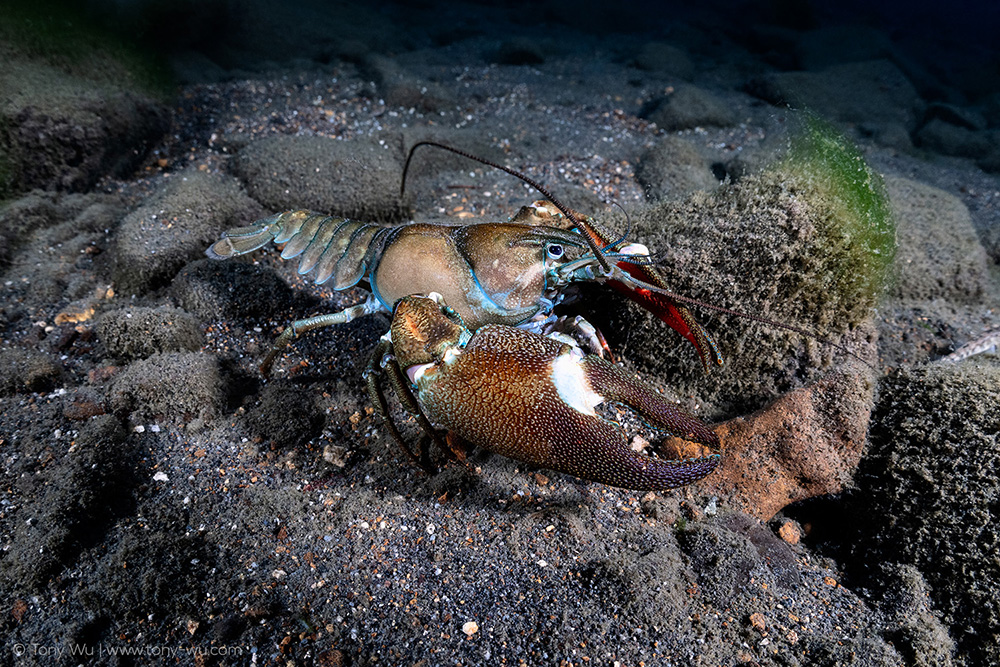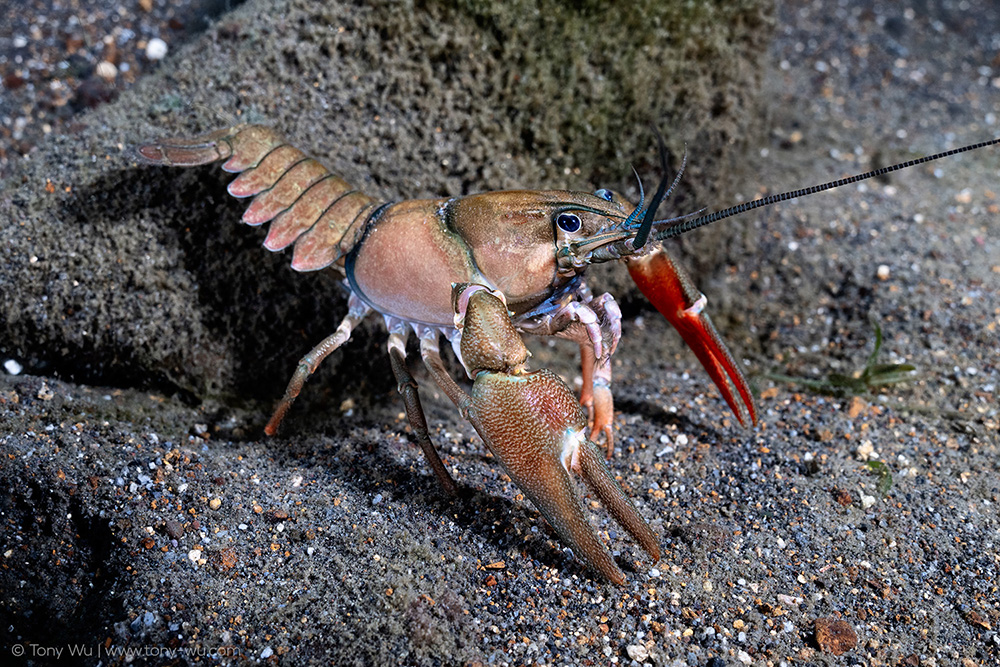This is a signal crayfish (Pacifastacus leniusculus):

These crustaceans are common in fresh water systems in several areas of Japan—Hokkaido, Shiga, Nagano, Tochigi, Fukushima and Chiba. Maybe other places as well.
This is not a good thing.
These crayfishes were brought to Japan from the USA in the late 1920s. One government source reports five deliberate introduction events via Portland, Oregon between 1926 and 1930 (1). A 2010 paper documenting the first official record of these crayfish in Chiba prefecture cites 1928 as the moment of introduction (2). Other sources I consulted point to different dates.
Whatever the case, the exact timing does not matter so much as the consequence.
Larger and more aggressive than Cambaroides japonicus, the crayfish species endemic to northern Japan, signal crayfishes have driven the native species out of many areas (3). The lake in Hokkaido where I took this photograph, for instance, should be home to lots of native crayfishes. I didn’t see a single one. The foreigners, by contrast, were everywhere.
Introduced species can also bring new diseases. I came across a paper citing mass die-offs of native crayfish in 2014 and 2015, with the suggested cause being crayfish plague (Aphanomyces astaci), a water mold that likely derived from Pacifastacus leniusculus (and Procambarus clarkii, another introduced North American crayfish species) (4).
Signal crayfishes are voracious. They eat many things and consume a lot. As a result, there are probably knock-on effects to other organisms and other aspects of the ecosystem that we do not know about.
I met a man who has been trying for many years to eliminate the signal crayfish from Hokkaido. He is one person, working with a limited number of volunteers, little to no funding. Signal crayfishes thrive in Hokkaido. Ridding even one lake of these hardy invasives seems an impossible task, much less making the entire island of Hokkaido signal-free. The good news is that he is cheerful and optimistic, happy to continue his efforts, despite his recognition that the probability of failure far exceeds that of success.

“So why were these animals transported across the Pacific in the first place?” you might wonder.
Apparently, the (bright?) idea was to sell them as food.
No one eats them. So total fail, and ecological catastrophe to boot.
_______________________________________
(1) Invasive Species of Japan - Pacifastacus leniusculus https://www.nies.go.jp/biodiversity/invasive/DB/detail/70050e.html
(2) Kazuyoshi Nakata, Norio Hayashi, Masumi Ozaki, Akifumi Ohtaka, Junji Miwa, First record of the North American invasive crayfish Pacifastacus leniusculus from the Kanto region, Tone River basin, central Japan: a range expansion to a warm water area, Plankton and Benthos Research, 2010, Volume 5, Issue 4, Pages 165-168 https://doi.org/10.3800/pbr.5.165
(3) The IUCN Red List status for this species is Data Deficient, population decreasing, with the most recent assessment done in 2010. The situation is viewed with more urgency within Japan. In 1998, The Japanese Fisheries Agency declared Cambaroidies japonicus endangered. The Environmental Agency followed suit in 2000.
(4) Martín-Torrijos L, Kawai T, Makkonen J, Jussila J, Kokko H, Diéguez-Uribeondo J. Crayfish plague in Japan: A real threat to the endemic Cambaroides japonicus. PLoS One. 2018 Apr 4;13(4):e0195353 https://doi.org/10.1371/journal.pone.0195353